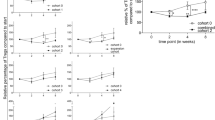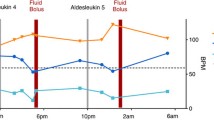Abstract
Metastatic renal cell cancer is one of the immuno-sensitive tumors. Apart from the immuno-modulating agents IFNα and IL-2, thalidomide has been reported to be effective in this type of cancer. However, bone metastases and bulky metastases, show limited response to immunotherapy, are often site of recurrent disease and are therefore often treated later with radiotherapy. In this phase II study, we evaluated toxicity and efficacy of the combination of continuous low dose (1 mIU/m2) s.c. IL-2 and thalidomide (200 mg once daily) in 22 patients with progressive metastatic renal cell cancer. In addition, 13 soft tissue lesions and two bone metastases in 13 patients were concurrently treated with fractionated radiotherapy. T cell number and activation in blood was measured by immunoflowcytometry. Nearly all patients developed grade 1–2 toxicity consisting of fatigue, sensory neuropathy, constipation and dizziness. Five patients had a grade 3–4 toxic event: four patients with deep venous thrombosis requiring anticoagulant therapy, and one patient who developed radiation myelopathy. On systemic response evaluation ten patients showed ongoing SD with a mean progression free survival of 9 months. One patient showed a PR (at an irradiated site). Regarding local response to irradiation, seven lesions showed a PR for a mean time period of 8.7 months, whereas seven were stable for 6 months. The radiation response of one lesion was not evaluable. Immunoflowcytometry showed an increase in number and activation of lymphocytes (mainly Natural Killer—NK-cells), which was absent or even decreased in irradiated patients. The combination of sc. low dose IL-2, thalidomide and radiotherapy is feasible, but relatively toxic and does not lead to higher responses at non-irradiated sites. The combination of immunotherapy and concurrent radiotherapy is effective at 60% of the relatively large evaluable sites. Progressive myelopathy developed in one patient, possibly due to radiotherapy in combination with thalidomide.


Similar content being viewed by others
References
Fosså SD (2000) Interferon in metastatic renal cell carcinoma. Semin Oncol 27:187–193
Rosenberg SA, Lotze MT, Muul LM et al (1987) A progress report on the treatment of 157 patients with advanced cancer using lymphokine activated killer cells and interleukin-2 or high dose interleukin-2 alone. N Engl J Med 316:889–893
Fyfe G, Fisher RI, Rosenberg SA et al (1995) Results of treatment of 255 patients with metastatic renal cell carcinoma who received high-dose recombinant interleukin-2 therapy. J Clin Oncol 13:688–696
Stein RC (1991) The clinical effects of prolonged treatment of patients with advanced cancer with low-dose subcutaneous interleukin-2. Br J Cancer 63:275–278
Negrier S, Escudier B, Lasset C et al (1996) Recombinant interleukin-2, recombinant human interferon α-2a or both in metastatic renal carcinoma. N Engl J Med 338:1272–1279
Eisen T (2000) Continuous low dose thalidomide : a phase II study in advanced melanoma, renal cell, ovarian and breast cancer. Br J Cancer 82:812–817
Motzer RJ, Berg W, Ginsberg M et al (2002) Phase II trial of thalidomide for patients with advanced renal cell carcinoma. J Clin Oncol 20:302–306
Escudier B, Lassau N, Couanet D et al (2002) Phase II trial of thalidomide in renal cell carcinoma. Ann Oncol 13:1029–1035
Nathan PD, Gore ME, Eisen TG et al (2002) Unexpected toxicity of combination thalidomide and interferon alpha-2a treatment in metastatic renal cell carcinoma. J Clin Oncol 20:1429–1430
Amato RJ, Schell J, Thomson N et al (2003) Phase II study of thalidomide + interleukin-2 in patients with metastatic renal cell carcinoma. Proc ASCO 22:387a (abstract 1556)
Olencki T, Malhi S, Mekhail T et al (2003) Phase I trial of Thalidomide and interleukin-2 in patients with metastatic renal cell carcinoma. Proc ASCO 22:387 (abstract 1554)
Younes E, Haas GP, Deszo B et al (1995) Local tumor irradiation augments the response to IL-2 therapy in a murine renal adenocarcinoma. Cell Immunol 165:243–251
Younes E, Haas GP, Deszo B et al (1995) Radiation-induced effects on murine kidney tumor cells: role of the interaction of local irradiation and immunotherapy. J Urol 153:2029–2033
Lam JS (1995) Effect of local tumor irradiation and interleukin-2 therapy in different murine tumors. J Imm Ther 18:28–34
Dezso B, Haas GP, Hamzavi F et al (1996) The mechanism of local tumor irradiation combined with interleukin-2 therapy in murine renal carcinoma : histological evaluation of pulmonary metastases. Clin Can Res 2:1543–1552
Lange JR (1992) A pilot study of the combination of interleukin-2 based immunotherapy and radiation therapy. J Imm Ther 12:265–271
Redman BG (1998) Phase II trial of sequential radiation and interleukin-2 in the treatment of patients with metastatic renal cell carcinoma. Clin Can Res 4:283–286
de Gast GC, Klümpen HJ, Vyth-Dreese FA, Kersten MJ, Verra NCV, Sein J, Batchelor D, Nooijen WJ, Schornagel JH (2000) Phase I Trial of combined immunotherapy with subcutaneous granulocyte macrophage colony-stimulating factor and interferon α in progressive metastatic melanoma and renal cell carcinoma. Clin Can Res 6:1267–1272
Simon R (1989) Optimal two-stage designs for phase II clinical trials. Controlled Clin Trials 10:1–10
Eisen T (2002) Thalidomide in solid malignancies. J Clin Oncol 20:2607–2609
Kumar S, Witzig TE, Rajkumar SV (2004) Thalidomide: current role in the treatment of non-plasma cell malignancies. J Clin Oncol 22:2477–2488
Smith KA (1993) Lowest dose interleukin-2 immunotherapy. Blood 81:1414–1423
Caligiuri MA, Murray C, Robertson MJ et al (1993) Selective modulation of human natural killer cells in vivo after prolonged infusion of low dose recombinant interleukin-2. J Clin Invest 91:123–132
Wilson D, Hiller L, Gray L et al (2003) The effect of biological effect dose on time to symptom progression in metastatic renal cell carcinoma. Clin Oncol 15:400–407
Author information
Authors and Affiliations
Corresponding author
Rights and permissions
About this article
Cite this article
Kerst, J.M., Bex, A., Mallo, H. et al. Prolonged low dose IL-2 and thalidomide in progressive metastatic renal cell carcinoma with concurrent radiotherapy to bone and/or soft tissue metastasis: a phase II study. Cancer Immunol Immunother 54, 926–931 (2005). https://doi.org/10.1007/s00262-005-0677-2
Received:
Accepted:
Published:
Issue Date:
DOI: https://doi.org/10.1007/s00262-005-0677-2




